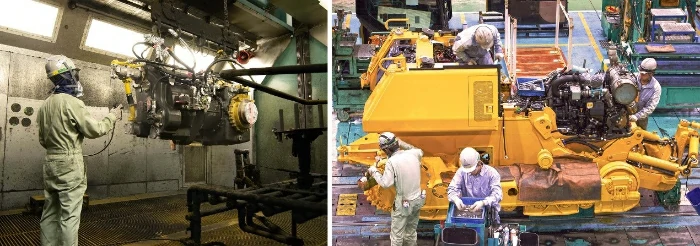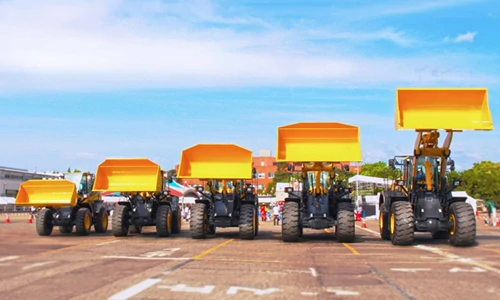Komatsu bases and networks around the world ! ! !
The Earth – our common home, Komatsu – moving forward in sync with the world.
In order to better meet the needs of global customers, Komatsu’s bases and networks are constantly expanding.
Currently, Komatsu has 60 production bases, and the proportion of overseas production has reached 63%. There are 55 sales companies, and sales and service agencies are spread across 150 countries and regions, reaching 211.
This time, we will introduce you to one of the production bases – Awazu Plant.
The birthplace of Komatsu-Awazu Factory in Komatsu City
The Awazu Factory was established in 1938 in Komatsu City, Ishikawa Prefecture, Japan, the birthplace of Komatsu. At the time of its establishment, its main products were agricultural equipment such as tractors. In the 85 years to date, along with Komatsu’s continuous development history, the Awazu Factory has always played an important role as Komatsu’s main factory in the world.
The Awazu Plant covers an area of about 720,000 square meters, which is equivalent to about 15 Tokyo Stadiums nicknamed “Tokyo Domes”. It is Komatsu’s largest plant in Japan, and one of its characteristics is “production efficiency”.
With advanced technology and perfect production processes, it undertakes the manufacturing of multiple categories of products. In particular, the transmission, one of the core assemblies that determines the performance of construction machinery, is developed and produced by the Awazu Plant and provided to Komatsu-related production plants around the world. In addition, the four products of small and medium-sized bulldozers, hydraulic excavators, wheel loaders, and motor graders are produced on the same two assembly lines, realizing the simultaneous production of multiple categories of products.

Another feature of the Awazu Plant is “environmental protection”. Aiming to become a future-oriented advantage factory (DantotsuFactory), the Awazu Plant is constantly evolving through new concepts. For example, in the assembly line of construction machinery, by making full use of the underground space of the workshop and adopting a resilient concrete floor, the equipment is stored in the underground space, realizing a spacious production area and a comfortable environment, and making the layout adjustment more flexible.
In addition, the factory has made great use of the natural environment and made the most of natural energy such as solar energy and biomass energy, achieving significant energy saving improvements. At the same time, the Awazu Factory has also actively adopted environmentally friendly measures such as geothermal utilization, natural lighting systems composed of roof skylights and LED lighting.
The Awazu Factory has always been at the forefront of the times in both production and environmental response. It can do this because it was born in Komatsu City, the birthplace of Komatsu, and inherited Komatsu’s entrepreneurial spirit.
Komatsu was born in Komatsu City in 1921, and its visionary founder, Mr. Takeuchi Akitaro
Komatsu’s predecessor was Komatsu Iron Works, a mining-affiliated machinery processing plant established at the Yusenji Copper Mine in Komatsu City, Ishikawa Prefecture, Japan. In 1921, Komatsu Iron Works separated from the mine and changed its name to Komatsu Manufacturing, and has since developed as an independent machinery manufacturing company.
The company name “Komatsu” comes from the place name. Its founder is Takeuchi Akitaro, a famous industrialist in modern Japan. He devoted his life to raising Japan’s backward industry to the world’s advanced level. In 1900, Mr. Takeuchi Akitaro began to realize that Japan’s industry must go global. At that time, at the “Paris World Expo” held in France, Mr. Takeuchi Akitaro witnessed the progress of world mechanical technology. Since then, Mr. Takeuchi Akitaro has a strong belief that “without the development of industry, there will be no development of the country”. During the period from the Meiji era to the Taisho era in Japan, he devoted all his dreams and enthusiasm to cultivating Japan’s industry and proposed the ambitious goal of building “Komatsu with the world as its stage”.
At that time, Mr. Takeuchi Akitaro put forward the following requirements:
Avoid all waste in business facilities;
Products must be “perfect”;
Research work must not be slack for a moment;
For future development, talent training must be done at all costs;
The degree of automation of products must be as high as possible;
After achieving product localization in the future, further exploration of ways to export products should be made;
Profit is secondary.

These concepts are still being passed down in Komatsu today. Striving to develop technologies that are welcomed by the world, taking the world as a stage, and taking endless challenges has become the corporate DNA of Komatsu today and has been carried forward.


